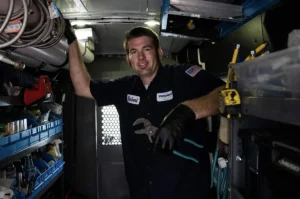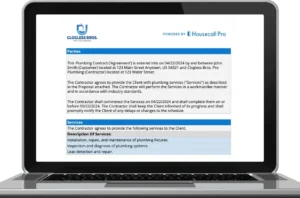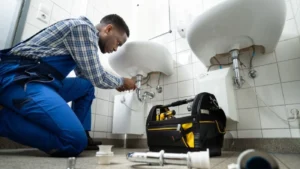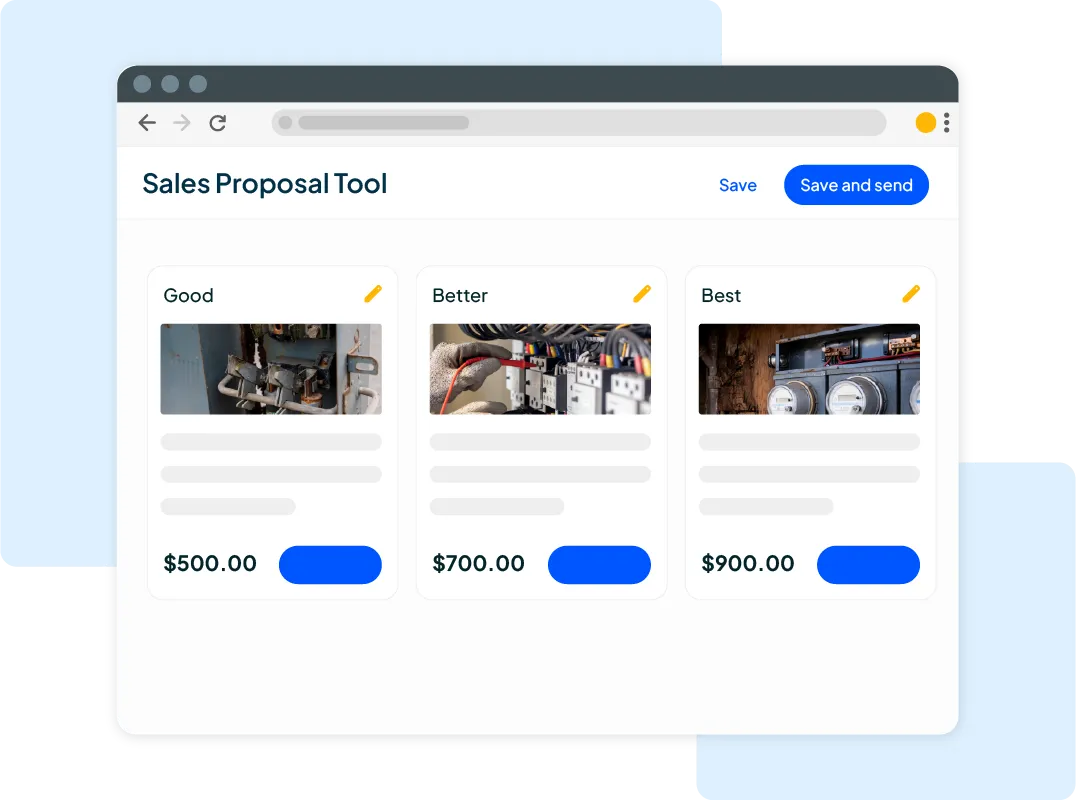Want to win more jobs with less effort?
Grow your business and send quick quotes with our home service software.

Want to see your potential revenue?
See what businesses like yours earn with Housecall Pro in 1 - 2 minutes.
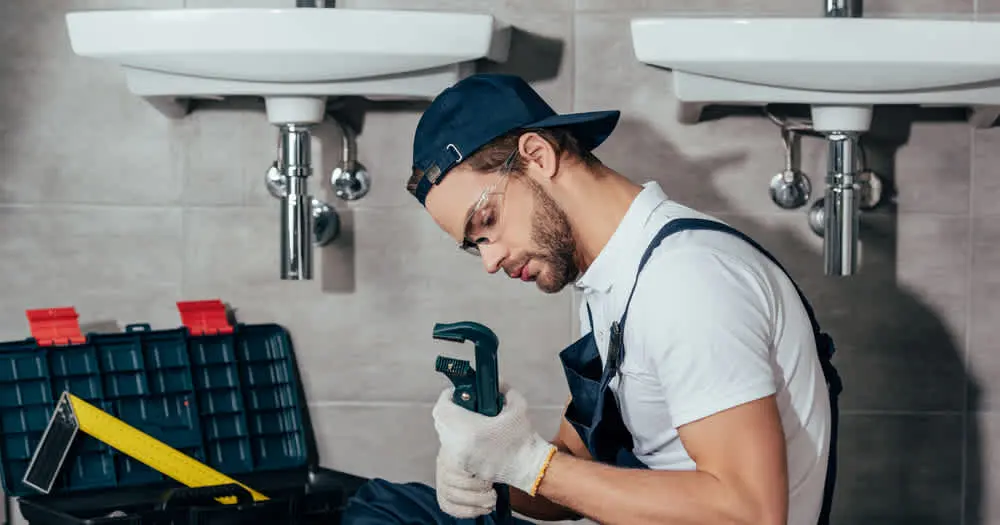
Starting a plumbing business is an exciting way to gain more freedom, control, and earning potential than working for someone else. But you’ll need more than some tools and a van to succeed. You also need a game plan for things like licenses, insurance, marketing, and finding steady clients.
In this step-by-step guide, we’ll walk you through exactly how to get your plumbing business off the ground. We’ll also provide expert tips from successful business owners to help you avoid rookie mistakes.
- Plumbing business startup checklist
- Step 1: Get your plumbing license
- Step 2: Create a plumbing business plan
- Step 3: Secure business financing
- Step 4: Register and license your plumbing business
- Step 5: Get plumbing business insurance and bonding
- Step 6: Buy plumbing tools and equipment
- Step 7: Set plumbing prices
- Step 8: Market your plumbing business to get clients and leads
- Step 9: Grow your plumbing business
- How Housecall Pro’s plumbing software can help
Plumbing business startup checklist
Use the checklist below as your roadmap to set up a profitable plumbing business. We’ll break down each step in the sections that follow.
- Get your plumbing license.
- Create a business plan.
- Secure funding.
- Register and license your business.
- Get insurance and bonding.
- Buy plumbing tools and equipment.
- Set prices.
- Market your plumbing company.
- Grow your business.
Step 1: Get your plumbing license
Most states require a license for plumbing work that goes beyond basic repairs. For example, Massachusetts requires licensing for all plumbing work, while Louisiana requires a contractor’s license for plumbing jobs over $10,000 in labor and material costs.
You have a few training options to become a plumber:
- Trade school: Classroom learning that covers plumbing theory and safety with practice sessions.
- Apprenticeship: Paid, on-the-job training under a licensed plumber.
- Combination: Mix of classroom training and fieldwork to balance technical knowledge with real-world experience.
While specifics differ by state, these are the typical steps to get a license:
- Earn a high school diploma or GED
- Choose your training path (trade school, apprenticeship, or a mix of both)
- Complete a 4–5 year apprenticeship
- Get 2,000–8,000 hours of supervised work experience (varies by state)
- Apply for and pass the state licensing exam (usually 75%+ correct)
- Submit your exam results, documentation, and proof of insurance to apply for a license
- Pay the licensing fee
Plumbing licenses typically need to be renewed every 1–2 years, depending on your state. Aside from paying a renewal fee, you also need to take up to 12 hours of continuing education (CE), again depending on your state. Check with your local licensing board for exact details.
Step 2: Create a plumbing business plan
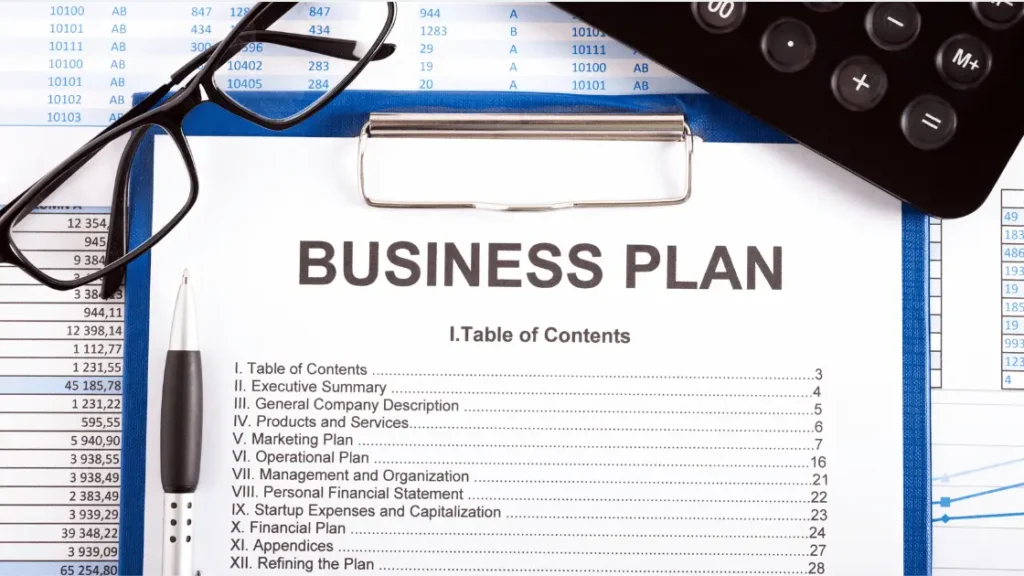
Before you start booking jobs, you need a clear business plan. This means laying out your target market, budget, services, pricing, and marketing strategy. More importantly, it means thinking through challenges before they arise.
“Too many new owners jump in with tools and a truck but no real roadmap for how to run the business side,” says Danny Wilcox, marketing manager at Carini Home Services. “Know your licensing requirements, have your insurance lined up, and understand your market.”
A solid business plan includes the following elements. We’ll walk through how to get started below.
- Executive summary: A snapshot of your business goals, what your company does, and the outcomes you want to achieve.
- Company overview: An outline of your plumbing business, including your mission, vision, and the core services you’ll provide. (Tip: This is often easiest to write after you’ve filled out the rest of your plan.)
- Market research: An analysis of your ideal customers, local competition, and overall demand in your area.
- Services: A clear list of the plumbing work you’ll specialize in and offer to clients.
- Sales approach: How you plan to win new customers and convert leads into long-term clients.
- Startup costs and funding: An estimate of the money you’ll need to launch, along with potential sources of funding if needed.
- Financial projections: Forecasts for revenue, expenses, and profit margins over the next few years.
- Marketing strategy: Tactics you’ll use to promote your services and build brand awareness.
- Appendix: Supporting documents such as licenses, certifications, or other relevant paperwork.
Free download: How to write a plumbing business plan (template)
Research your market and competitors
Search for “plumbers near me” on Google Maps, browse Yelp reviews, or check your local Chamber of Commerce directory to find your competitors.
Take note of their core business details, including:
- Services offered: Do they stick to residential jobs, or do they handle commercial work, too?
- Pricing structure: Do they advertise flat rate job prices or charge per hour?
- Marketing approach: Are they active on social media or do they rely on traditional promotional methods?
Your goal is to spot gaps in competitors’ services. For example, if you notice frequent complaints about long wait times, positioning yourself as a same-day plumber could set you apart.
Create a plumbing services list
Danny Penn, president of New Era Plumbing & HVAC, recommends starting simple with service offerings: “Take on the small jobs you can knock out fast and do well.” This might include core plumbing jobs like:
- Drain cleaning and unclogging
- Emergency repairs, like burst pipes or leaks
- Fixture installation (toilets, sinks, and faucets)
- Pipe replacement
- Water heater repair and installation
Once you’ve built a steady customer base, you can expand into more complex areas like tankless water heaters, pipe relining, or light commercial plumbing.
Set goals
Set realistic, trackable milestones. Instead of saying, “I want to grow my business,” aim for “20 repeat clients by the end of the year.” That way, you’ll know if you’re actually making progress.
Your short-term goals might include retaining 45% of clients in three months, hitting your first $5,000 in revenue in the second quarter, or saving enough to buy advanced tools within your first year.
Long-term, you might aim to expand into commercial projects or hit six figures in yearly revenue. These goals will help you build a clear roadmap that turns short-term wins into sustainable growth.
Pro tip: Housecall Pro helps you track service costs, customer info, and repeat jobs to create accurate projections and set goals.
Step 3: Secure business financing
According to the Small Business Association (SBA), 75% of startups rely on personal savings. If you don’t quite have the capital, here are some options to fund your plumbing business:
- Government funding: Financial awards provided by state, local, and federal governments to support small businesses.
- SBA loans: Low-interest loans backed by the federal government.
- Business line of credit: Continuous funding up to a predetermined credit limit.
- Business grant: Free funding from government or private groups; no repayment required.
How much does it cost to start a plumbing company?
Starting a plumbing company can cost anywhere from $10,000 to over $50,000, depending on where you work, the size of your operation, and whether you buy new or used equipment.
Here are the most common expenses to plan for:
- Equipment and supplies: $5,000–$15,000
- Work truck: $10,000–$50,000
- Licensing and permits: $80–$420
- Insurance: $1,000–$4,000
- Marketing and branding: $1,500–$5,000
- Initial operational expenses (transportation, uniforms, small tools): $1,000–$3,000
Pro tip: Even if you’re using personal savings to fund the startup, keep your personal and business finances completely separate. Open a dedicated business checking account and apply for a business credit card so every expense is tracked properly. This not only simplifies bookkeeping and taxes but also helps you build business credit early.
Step 4: Register and license your plumbing business
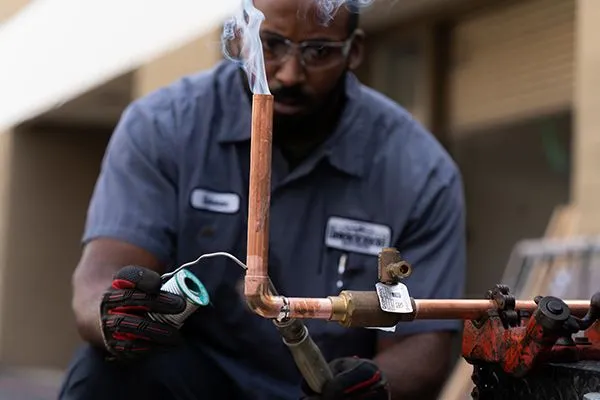
Getting your plumbing business properly registered and licensed builds trust with customers, keeps you out of legal trouble, and opens the door to bigger projects and better insurance rates. Skip it, and you could face fines of up to $10,000.
Here’s what to do.
Choose a business structure
Your business structure affects your taxes, liability, and overall business setup. At a glance, these are the differences between each business structure:
| Structure | Description | Pros | Cons |
|---|---|---|---|
| Sole proprietorship | Owned and operated by one person | -Low startup costs -Simple setup -Full control -Minimal regulations | -Personally liable -Hard to get loans -Business ends if owner exits |
| Limited liability company (LLC) | Owned by one or more members | -Protects assets -Flexible tax options -Easy ownership transfer | -Higher fees -May dissolve if a member exits |
| Partnership | Owned by two or more people | -Protects assets -Flexible tax options -Easy ownership transfer | -Personally liable -Disagreements may slow decisions -Profit sharing |
| Corporation | Owned by shareholders | -Good liability protection -Easy to raise capital -Business continuity | -High startup/maintenance costs -Double taxation -More rules/paperwork |
Many new plumbers start as an LLC or sole proprietorship, as these structures are easiest to set up. Check local and state regulations for forming each structure. If you’re unsure which is right for you, speak to an accountant or attorney.
Apply for a business license
After forming your business, you’ll need to apply for the necessary licenses to operate legally. Check these official government portals for local licensing requirements:
- City or county clerk’s office website
- State contractor licensing board
- Local Chamber of Commerce directories
Because each jurisdiction sets its own rules, confirm whether you need a plumbing contractor’s license in addition to your business license.
Pro tip: Paperwork can pile up fast and become a hassle to manage. When you store digital copies in Housecall Pro, you can pull them up instantly whenever you need them.
Step 5: Get plumbing business insurance and bonding
Insurance protects your business from financial losses and keeps you legally compliant. These are the common policies required for plumbing businesses:
- General liability insurance: Covers property damage and third-party injuries resulting from your work.
- Workers’ compensation: Necessary if you plan to hire employees; covers medical care and lost wages after workplace accidents.
- Commercial auto insurance: Protects service vehicles and drivers while traveling between job sites.
- Bonding: Provides financial protection if you fail to meet contract terms.
Coverage costs vary by provider. Compare quotes from different vendors to get the best protection at a fair price.
Step 6: Buy plumbing tools and equipment
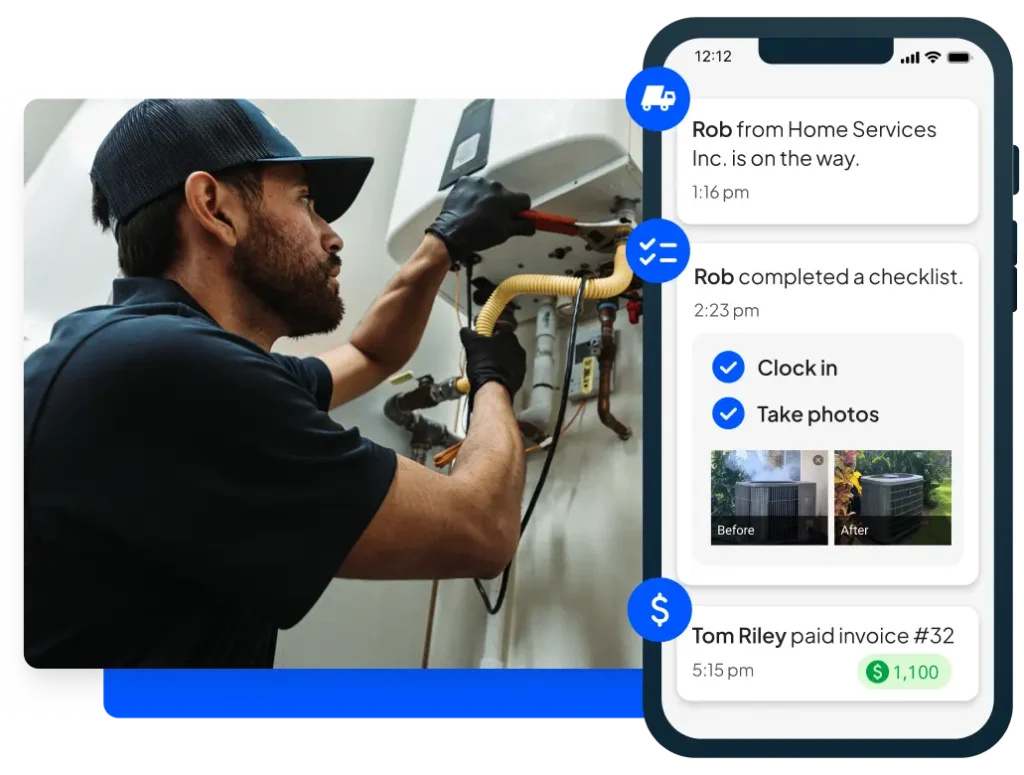
Having the right plumbing tools makes your jobs easier. Here are the essentials:
- Hand tools: Pipe wrenches, basin wrenches, pliers, tubing cutters, plungers, and tape measures
- Power tools: Drill sets, inspection cameras, drain augers, and press tools
- Safety equipment: Gloves, goggles, ear protection, and respirators
- Vehicles: A service van or truck with secure storage for tools
As a new plumbing contractor, budget $1,000–$5,000 for basic tools. These prices might seem high, but you can keep costs low by:
- Buying used equipment in good condition, then upgrading your kit as your business grows.
- Scheduling regular maintenance for your tools to save you from expensive repairs.
- Renting specialized tools for one-off or rare jobs until there’s enough client demand to justify buying.
Penn also recommends looking into credit lines through supply houses. “This means that the supplier lets you buy parts and materials on 30-day terms instead of paying cash up front, so you can pick up a $1,200 water heater today, finish the job, and use the customer’s payment to cover the bill—instead of draining your own pocket.”
Step 7: Set plumbing prices
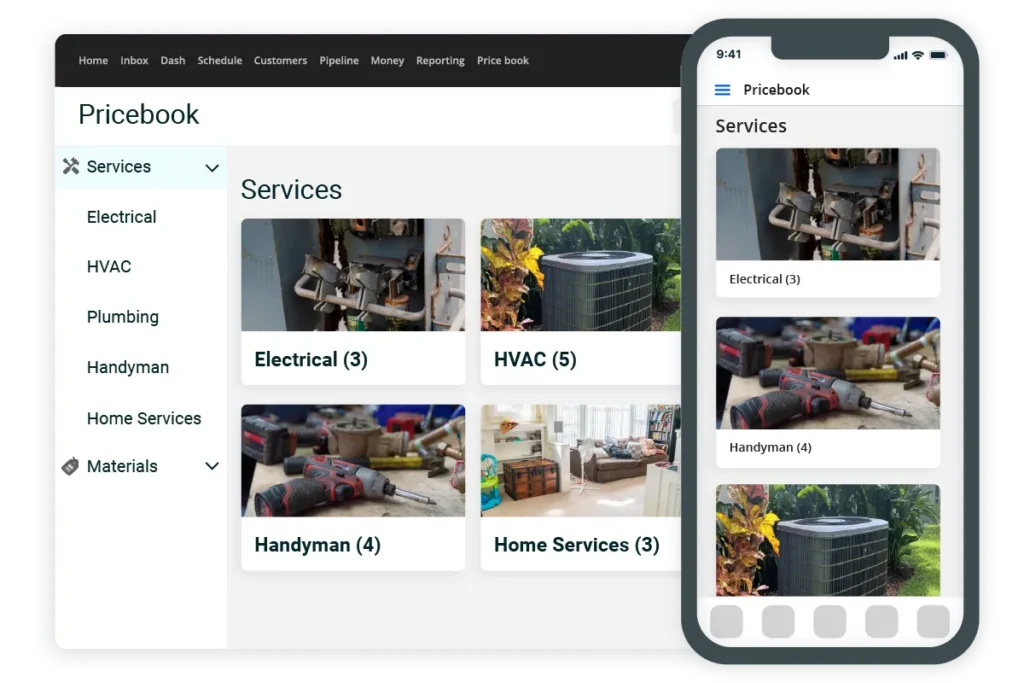
Figuring out how to price plumbing jobs is one of the most important parts of running your business. Charge too little, and you’ll struggle to cover costs. Charge too much, and you might have trouble attracting customers. The goal is to find that sweet spot where you’re making a profit while still staying competitive in your market.
Pro tip: Download our plumbing price book template to help you organize your services and keep rates consistent.
Choose a pricing model
Before setting rates, decide how you’ll bill your customers. Different pricing models work better for different types of jobs, so pick the one that fits your services and makes billing easiest.
Here are some common options:
- Hourly pricing (best for predictable jobs): You bill for the total time spent on the job.
- Flat rate pricing (best for routine tasks): You charge a fixed rate for a specific service.
- Hybrid pricing (best for large projects with add-ons): You set a flat rate for standard tasks but bill hourly for extras.
Set your rates
One of the biggest mistakes new plumbers make is underpricing to win new jobs. “If you’re spending $75 in marketing to land a call, you can’t charge $100 for a repair,” says Penn. “Track your lead cost and build your pricing based on that, or your ads and overhead will eat your profit.”
Use the simple formula below to set rates that cover costs and leave room for profit:
Service price = labor costs + material costs + overhead costs + profit margin
Follow these steps to apply the formula:
- Calculate your base costs: Add up the amount you spend on materials, labor, and overhead.
- Add your profit margin: Aim for a profit margin between 20% and 30% to stay profitable without overpricing.
- Research competitor pricing: Use competitor pricing as a benchmark to set your own rates.
- Adjust based on service type: A simple drain clean might use flat rate pricing, while a remodel with unknown variables could work best with hourly or hybrid pricing.
Pro tip: Plug your figures into Housecall Pro’s plumbing service price calculator, plumbing profit margin calculator, and labor cost calculator to speed up the math.
Step 8: Market your plumbing business to get clients and leads
Getting your plumbing business off the ground isn’t just about doing great work—it’s about making sure people know you exist. Marketing helps you reach the right customers, build trust, and turn one-time clients into repeat business.
Read more: The best plumbing marketing strategies to dominate your market
Design your brand
Your brand sets the tone for how customers see you. Keep it simple, professional, and memorable by implementing these tips:
- Pick a business name and logo that reflect your services.
- Make sure your domain name and social media handles are available before finalizing.
- Use consistent messaging across sales and marketing channels to build trust and recognition.
Build an online presence
Over 50% of customers use Google to discover a new brand, and this is often the first place customers look when they have a plumbing issue. Follow these tips to build an online presence and show up when prospects search for nearby plumbers:
- Create a user-friendly website with service descriptions, pricing, and clear contact options.
- Claim your Google Business Profile to boost local visibility.
- Use social media marketing to reach customers on Facebook, X, and Instagram.
- Showcase client testimonials on your website and social media pages to build trust.
Use offline marketing strategies
Traditional marketing is still a powerful way to reach local customers, especially homeowners and busy professionals who aren’t active online. Emily Demironder, the director of operations and marketing at Proximity Plumbing, started by printing 10,000 flyers and delivering them firsthand. This helped the company establish trust through word of mouth. “Before spending any money on ads, we got Google reviews from actual locals,” she says.
Here are some other offline marketing tactics to consider:
- Sponsor community events to build goodwill and visibility.
- Get vehicle wrapping to turn your work van into a rolling billboard.
- Partner with local businesses like realtors or property managers.
- Ask satisfied customers for referrals to grow your client base organically.
Prioritize customer service
Marketing gets customers in the door; great service keeps them coming back, earns positive reviews, and generates referrals that grow your business. “Your first 20–30 calls set your reputation. Even if they’re ‘small jobs’ like a leaky faucet or a clogged toilet, treat them like gold,” says Penn. “They’ll do the job by giving you those first good reviews, sending referrals, and bringing you repeat and new calls.”
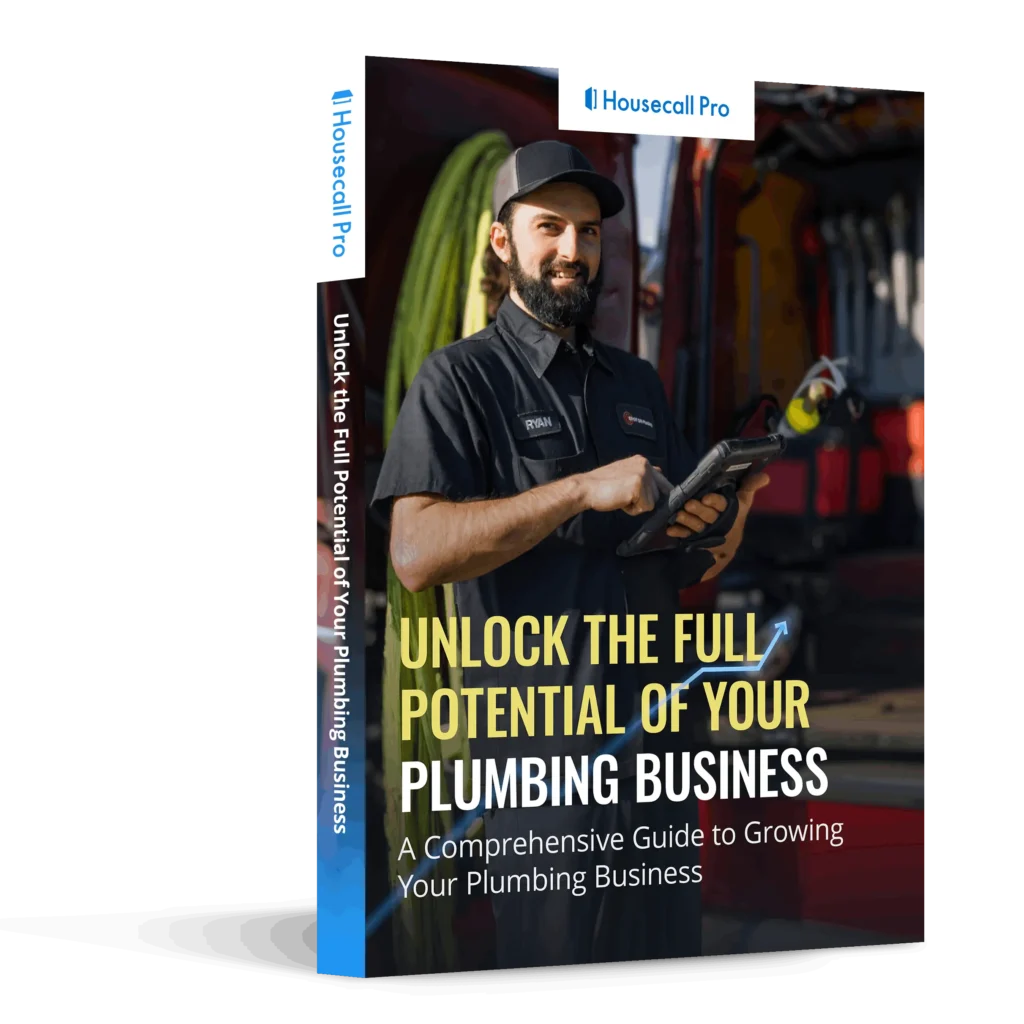
Free ebook download: Unlock the full potential of your plumbing business
Step 9: Grow your plumbing business
Once you’ve landed steady clients and built a solid reputation, it’s time to think bigger. Growing your plumbing business means expanding your services, extending to new neighborhoods or cities, and finding ways to bring in more customers without burning out.
Before making any big moves, review your income and expenses to make sure your business has the financial stability to handle growth. Here are some signs it might be time to expand:
- You’re consistently turning away jobs because your schedule is full.
- Customers are requesting services you don’t currently offer.
- You’re seeing steady growth in repeat customers and referrals.
- Your revenue is stable enough to invest in additional staff, equipment, or marketing.
Once you notice these signs, you can start planning strategically—whether that’s hiring help, adding services, or investing in tools and software to streamline your operations.
Hire plumbers
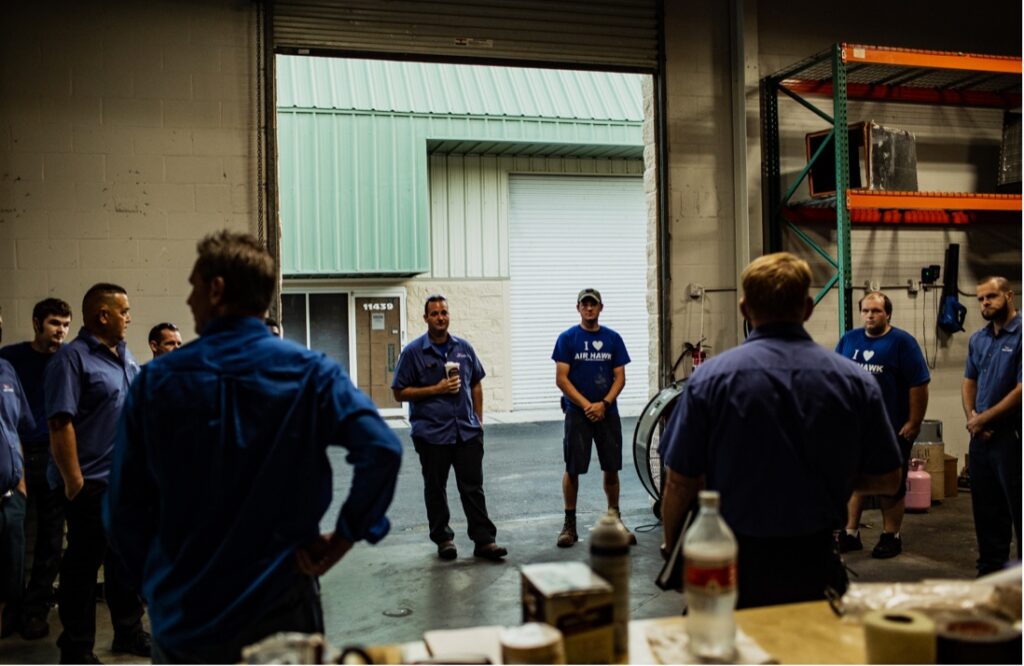
If your workload outgrows what you can do alone, it’s time to bring in help. Whether you recruit full-time employees or independent contractors, follow these best practices to build a reliable team:
- Define the role clearly, including role and pay.
- Recruit through local job boards, trade schools, or industry networks.
- Screen candidates by reviewing resumes and checking references.
- Verify certifications, licenses, and insurance for compliance and safety.
- Interview applicants to assess skills and cultural fit.
- Train staff to maintain service quality.
- Set clear expectations, track performance, and offer employee training.
Free downloads:
- Ultimate Guide to Hiring and Leadership (ebook)
- Plumbing installer job description template
- Plumbing service technician job description template
- Plumbing journeyman job description template
How Housecall Pro’s plumbing software can help
Running a plumbing business means juggling schedules, managing clients, tracking jobs, and keeping your finances in order. That can be a lot to bite off—especially when you’re just starting out.
Housecall Pro’s plumbing software can help you stay organized, save time, and more easily manage the day-to-day. Here’s how:
- Scheduling and client management: Book appointments, send reminders, and manage recurring jobs.
- Pricing and invoicing tools: Use plumbing estimating and invoicing software to calculate rates and send invoices.
- Marketing and client acquisition: Automate follow-ups, track reviews, and manage referrals with automated marketing tools.
- Operational efficiency: Process payments, complete digital forms, and access everything on mobile.
- Growth support: Manage employees, contractors, and even multiple locations as your plumbing business scales.
Try our free 14-day trial to see why we’re trusted by 200,000+ Pros across 50+ trades.
*Data based on average monthly revenue generated through Housecall Pro after the first year of using the platform.
Starting a Plumbing Business FAQ
-
Is it a good idea to start a plumbing business?
-
Yes, it is a good idea to start a plumbing business. With steady demand for repairs, installations, and emergency services, plumbing is a reliable trade and offers strong growth potential.
-
Is a plumbing business profitable?
-
Yes, a plumbing business can be profitable. Many small plumbing companies report six-figure revenues, especially when pricing is set correctly and overhead stays low.
-
What type of plumbing service makes the most money?
-
Plumbing specialties (new construction, commercial, after-hours/emergency) and regular maintenance contracts generally pay the most.
-
What license do I need to start a plumbing business?
-
Most states require a plumbing contractor’s license and a general business license. Check your state’s contractor board or licensing authority for the exact requirements.
-
How profitable is a plumbing business?
-
A plumbing business can be very profitable, with many plumbers earning six figures annually. Profitability depends on factors like pricing, overhead costs, and customer volume. Offering maintenance plans, emergency services, and upselling additional services can boost revenue.


